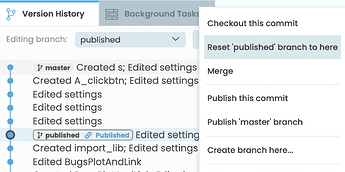Continuing the discussion from [Beta] How do I depend from the development version of an app?:
Thank you.
I did a quick test and I got it to work quickly.
Mmmh… should I go ahead with the little rant about the master branch?
Why not? Here it is ![]()
As I said, I did a quick test and this is what I found out:
-
The default branch is
masterand the default environment isPublished.
I created a new app and there was themasterbranch only.
I clicked onPublishand it created thePublishedenvironment linked to themasterbranch. -
The
masterbranch seems to be the production branch by design.
I clicked theUnpublish 'master' branchbutton, then I created thedev1anddev2branches. At this point:- Checking out
mastershows thePublish 'master' branchbutton - Checking out
dev1shows theMerge changes into masterbutton - Checking out
dev2shows theMerge changes into masterbutton
- Checking out
-
The
masterbranch seems to be the development branch by design.
I created the 4th branchpublished, then I created another app and used the first app as dependency.- The dependency version
Publisheduses thepublishedbranch - The dependency version
Developmentuses thedevelopmentbranch
- The dependency version
The two behaviors 2. and 3. seem to be contradicting each other.
I have already created a feature request about killing the master branch a few months ago. After a few months I got used to dealing with it and paying close attention to avoid breaking a production app, however not one day has passed without inadvertently editing the master branch of a production app for at least a few seconds, and in a few cases for long enough to hear from a few users. I still very strongly believe the master branch does not belong in Anvil as is. My hopes to see my FR addressed are low, but my opinion doesn’t change:
I do have one request about the dependency management, but it is not about branches and environment.
I have not created any feature request about the relation between branches, environments and dependencies, because there are many posts out there and many hints that something is being developed (with a quick search I found one and two).
I am confident that whatever improvement will appear, it will be less confusing.
I’ll wait and see.
(I know, it sounds like a rant, but I am trying to be constructive)


